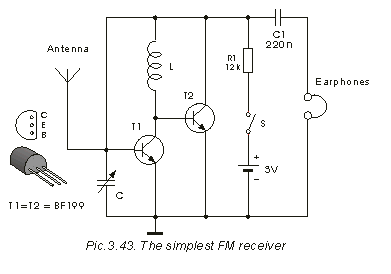3.15.1 The Simplest FM Receiver
On Pic.3.43 you can se the electronic circuit of an extremely simple direct FM receiver. The T2 transistor together with the R1 resistor, the coil L the variable capacitor C and internal capacitances of the T1 transistor, comprises the so-called Kolpitz oscillator. The resonance frequency of this oscillator is being set by C to correspond to the one of the station that we wish to hear (meaning it has to be altered between 88 and 108 MHz). The signal, i.e. the information being used in the transmitter to perform the modulation, is extracted on the R1 resistor, and being led from it to the high-resistance headphones, over the coupling capacitor C1.
 * The capacitance of the variable capacitor should be able to change from a couple of pF (Cmin) to app. 20 pF. During the testing off this device, we were using the capacitor from Pic.3.8. The legs marked as FO and G were used, the G leg being connected to the ground. When all the trimmers from the circuit on the Pic.3.8 are set to minimum capacitance, the capacitance between the FO and G legs should be adjustable between 7 and 27 pF.
* The coil L has 4 quirks of lacquer-isolated copper wire (CuL), bended to have a 4 mm internal diameter. The practical realization of this coil is explained in text connected with Pic.3.45. During the setup of the bandwidth, the inductance of the coil can be altered by changing the distance between the quirks. If the coil is stretched the inductance decreases, and vice versa. If this cannot give the desired results, new coil must be made.
* The telescopic antenna taken from a disused device can be used. If you can’t find one, you obtain very good results with a piece of isolated copper wire, about 60 cm long (the optimum length to be found experimentally).
* The capacitance of the variable capacitor should be able to change from a couple of pF (Cmin) to app. 20 pF. During the testing off this device, we were using the capacitor from Pic.3.8. The legs marked as FO and G were used, the G leg being connected to the ground. When all the trimmers from the circuit on the Pic.3.8 are set to minimum capacitance, the capacitance between the FO and G legs should be adjustable between 7 and 27 pF.
* The coil L has 4 quirks of lacquer-isolated copper wire (CuL), bended to have a 4 mm internal diameter. The practical realization of this coil is explained in text connected with Pic.3.45. During the setup of the bandwidth, the inductance of the coil can be altered by changing the distance between the quirks. If the coil is stretched the inductance decreases, and vice versa. If this cannot give the desired results, new coil must be made.
* The telescopic antenna taken from a disused device can be used. If you can’t find one, you obtain very good results with a piece of isolated copper wire, about 60 cm long (the optimum length to be found experimentally).

 * The capacitance of the variable capacitor should be able to change from a couple of pF (Cmin) to app. 20 pF. During the testing off this device, we were using the capacitor from Pic.3.8. The legs marked as FO and G were used, the G leg being connected to the ground. When all the trimmers from the circuit on the Pic.3.8 are set to minimum capacitance, the capacitance between the FO and G legs should be adjustable between 7 and 27 pF.
* The coil L has 4 quirks of lacquer-isolated copper wire (CuL), bended to have a 4 mm internal diameter. The practical realization of this coil is explained in text connected with Pic.3.45. During the setup of the bandwidth, the inductance of the coil can be altered by changing the distance between the quirks. If the coil is stretched the inductance decreases, and vice versa. If this cannot give the desired results, new coil must be made.
* The telescopic antenna taken from a disused device can be used. If you can’t find one, you obtain very good results with a piece of isolated copper wire, about 60 cm long (the optimum length to be found experimentally).
* The capacitance of the variable capacitor should be able to change from a couple of pF (Cmin) to app. 20 pF. During the testing off this device, we were using the capacitor from Pic.3.8. The legs marked as FO and G were used, the G leg being connected to the ground. When all the trimmers from the circuit on the Pic.3.8 are set to minimum capacitance, the capacitance between the FO and G legs should be adjustable between 7 and 27 pF.
* The coil L has 4 quirks of lacquer-isolated copper wire (CuL), bended to have a 4 mm internal diameter. The practical realization of this coil is explained in text connected with Pic.3.45. During the setup of the bandwidth, the inductance of the coil can be altered by changing the distance between the quirks. If the coil is stretched the inductance decreases, and vice versa. If this cannot give the desired results, new coil must be made.
* The telescopic antenna taken from a disused device can be used. If you can’t find one, you obtain very good results with a piece of isolated copper wire, about 60 cm long (the optimum length to be found experimentally).